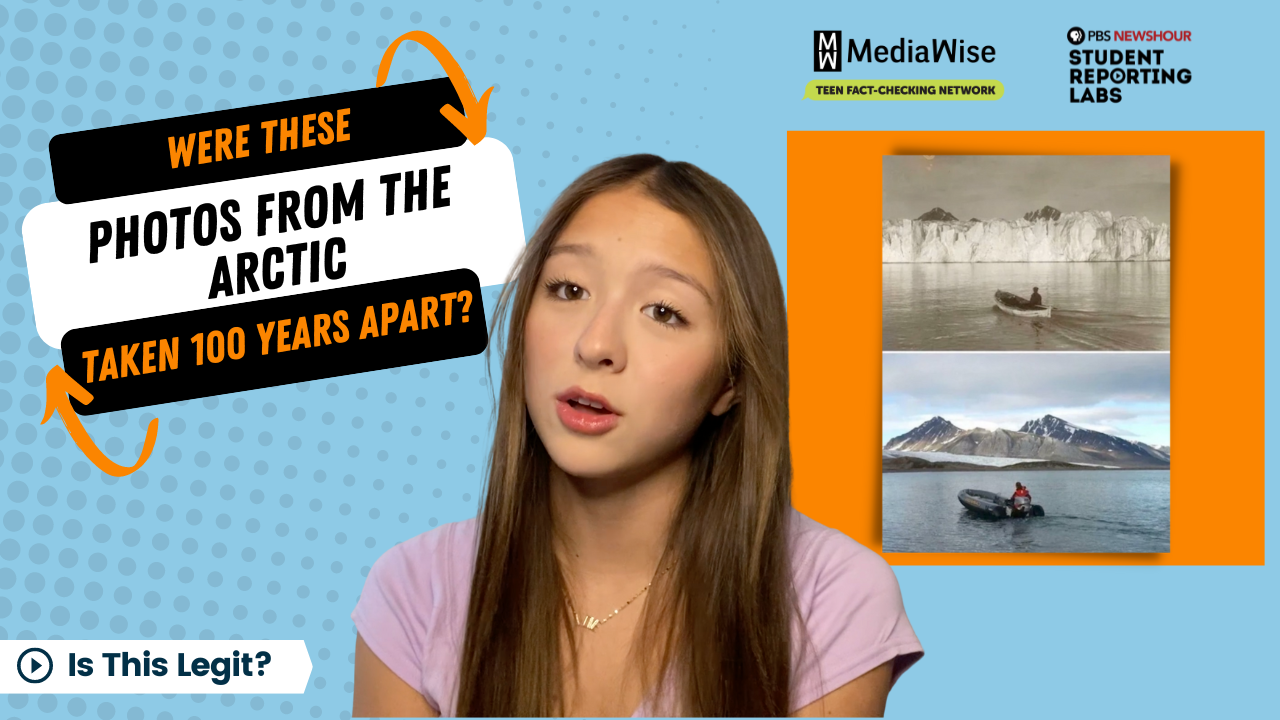Climate change is on everyone’s radar, so it is perhaps obvious why the following Tweet recently went viral:
“Two photos of the arctic taken 100 years apart showing the dramatic change in the continent’s ice cover. There is no time to waste. No planet B,” says the post from someone named Mike Hudema.
Underneath the caption are two pictures of the Arctic, with substantially more ice in the older photo than in the more recent one.
The Tweet’s message is clear: We as a society need to start taking climate-change seriously. But are these photos real? And if so, how do we know?
This is how we fact-checked it.
Ask the tough questions
When encountering images like these online, it’s important to ask these three questions from the Stanford History Education Group:
- Who’s behind the evidence?
- What is the evidence?
- What do other sources say?
First, who is Mike Hudema? After some quick Googling, we found a Wikipedia article that says Hudema is an environmental activist, which makes sense with the Tweet. He’s worked alongside organizations such as Greenpeace, for example. A quick Wiki-tip: Check out that little green plus symbol at the top right of the Wikipedia article: That means this is a Good Article, that it’s neutral and fact-based
Second, what is Hudema’s evidence? This is where Google Reverse Image Search comes in handy. This tool finds photos that are very similar to or match the uploaded image. It helps you find potentially vital context on the origins of the Tweet. The bottom line: Find out if the image is real — and from the time and place this Tweet says it’s from.
First you screenshot the tweet, crop it so that we only see the two images, and save it to your device. Then go to Google Images and drag and drop it into the search box. Several results pop up. But I scrolled down – practicing a media lit tip called “click restraint” – and found a headline from National Geographic, a well-known and trustworthy publication. The March 2017 article is headlined “Pictures Show Climate Change’s Dramatic Arctic Impact.”
According to the story, the more recent photo is credited to a person named Christian Åslund, a Swedish photojournalist who has worked with the environmental organization Greenpeace for years. In the article, he talks about a project he did in 2003 in which he chose photos taken of glaciers in the early 1900s, found where they had been taken and re-created them. It’s called a “glacier comparison.”
Dig deeper
But it was still unclear exactly when the first photograph was taken and whether – as commenters were asking – they were taken at the same time of year.
This brings us to the last question: What do other sources say? So I did a keyword search for “christian aslund glacier comparison” and found this Snopes article.
The Snopes article confirms that the photos do indeed show the exact same spot in the Arctic about a century apart. The older photo was from the early 1900s, and the more recent photo was from 2003.
And no, the photos don’t take place during different times of the year. According to Åslund, “Both images are from the summer season. … You can see it on the mountains, (in winter) the peaks would be covered. Also, the lack of sea ice. It wouldn’t be open water like that in the winter.”
Our Rating
We rate these images as Legit.
To recap, here’s how we figured it out:
- First, we checked out a Wikipedia article – one that had the green plus sign, meaning it was rated neutral and fact-based.
- Then we did a Google Reverse Image Search to find where the images had appeared in the past.
- Next, we practiced click restraint until I came across a credible publication.
- Finally, we used lateral reading to double-check exactly when the photos were taken.
Now, obviously, these photos alone don’t prove climate change is real – there are plenty of other scientific studies you can read for that. But they are a good visual comparison to help the human brain process the scale of what’s happening to the glaciers in the Arctic.
ATTENTION TEACHERS: This fact-check is featured in a free, one-hour lesson plan about how to check photos for context to avoid spreading misinformation. The lesson is available through PBS LearningMedia, and includes lesson summary and a handout, among other resources.






